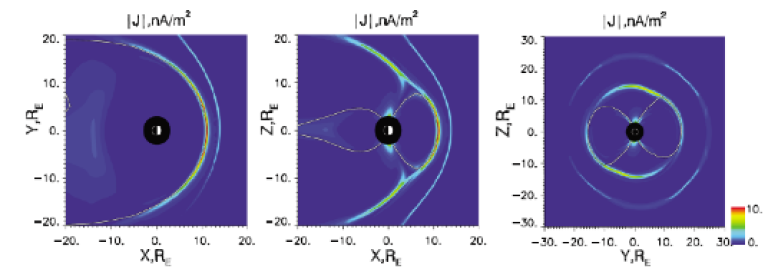PhD projects in Space Plasma Physics for our STFC studentships 2024 are listed below.
- Reconstruction of the dayside magnetopause using machine learning methods (Dr Colin Forsyth, Dr Andrei Samsonov)
- The kinetic stability of the solar wind (Dr. Daniel Verscharen)
Reconstruction of the dayside magnetopause using machine learning methods
Primary Supervisor: Dr Colin Forsyth, Dr Andrei Samsonov
The Earth’s magnetopause is the boundary between the solar wind and the magnetosphere. During coronal mass ejections, the solar wind dynamic pressure often increases and the magnetopause comes closer to the Earth. This may damage spacecraft travelling around the Earth on geosynchronous orbits. Besides, strong magnetospheric compression may influence the particles in the ring current.
During the last 50 years, space physicists have developed a number of empirical models to predict the magnetopause position using the database of in-situ spacecraft magnetopause crossings. However, empirical models usually assume a predefined analytical shape of the magnetopause and this may result in poor accuracy in some areas, particularly under extremes of solar wind driving. Numerical magnetohydrodynamic models (see Figure 1) also predict the magnetopause position, but they may not fully include all magnetospheric currents and physical processes, and therefore provide imprecise predictions as well.
We have now a very large database of magnetopause crossings in different regions and for different solar wind conditions. This growing number of space observations and outstanding advances in machine learning and artificial intelligence provide an opportunity for a breakthrough in our understanding of the magnetopause and modelling its global state.
This project will be directly related to the forthcoming Solar wind Magnetosphere Ionosphere Link Explorer (SMILE – https://mssl.ucl.ac.uk/SMILE/) mission. SMILE is a joint mission of the Chinese Academy of Sciences and the European Space Agency that will study the interaction of the solar wind with the Earth’s magnetosphere. One of the main instruments on board SMILE will be the Soft X-ray Imager (SXI) that will measure soft X-rays emitted in the magnetosheath and cusps. The SMILE team has been developing special numerical methods to find three-dimensional magnetopause shapes and positions from two-dimensional SXI images. SMILE is due for launch in 2025. A new state-of-the-art magnetopause model being available during the mission live time will provide predictions of magnetopause position near the subsolar point based on the solar wind observations, and, therefore, will facilitate the proper interpretation of SXI observations.

The electric current density distribution obtained by an MHD model indicates the magnetopause and bow shock positions. Adapted from Samsonov et al. (2016).
Desired Knowledge and Skills
- Undergraduate in physics, Earth sciences or astrophysics
- Strong computational skills (students will be encouraged to develop their own code as appropriate to deliver parts of the project)
The kinetic stability of the solar wind
Primary Supervisor: Dr Daniel Verscharen
The solar wind is a continuous plasma outflow from the Sun. Due to the solar wind’s low density and high temperature, collisions between plasma particles are very rare so that non-equilibrium conditions often develop. If these non-equilibrium conditions exceed certain thresholds, the plasma becomes unstable and drives the growth of electromagnetic or electrostatic fluctuations. These instabilities play a key role for the energetics of the solar wind as they re-distribute energy between the plasma particles and the electromagnetic fields.
A fleet of spacecraft measure the electromagnetic fields and the properties of the plasma in the solar wind. For example, the MSSL-led Solar Wind Analyser (SWA) instrument onboard the ESA mission Solar Orbiter is recording velocity distribution functions of the solar wind plasma (ions and electrons) with excellent cadence and resolution. These measurements show the non-equilibrium properties of the solar wind and the results of the action of plasma instabilities.
This project will combine direct spacecraft measurements from Solar Orbiter (and possibly other space-based assets) with modern analysis tools like the MSSL-led Arbitrary Linear Plasma Solver (ALPS) code to evaluate the stability and instability of the solar wind. The project will go beyond the assumptions of bi-Maxwellianity and homogeneity in order to develop a realistic picture of the instabilities in the solar wind. In this way, the project will ultimately evaluate the importance of plasma instabilities for the solar-wind thermodynamics under different solar-wind conditions and at different distances from the Sun.
Desired Knowledge and Skills
- Undergraduate in physics or astrophysics
- Good understanding of electromagnetism and statistical physics
- Computational and data-visualisation skills are desired
 Close
Close

